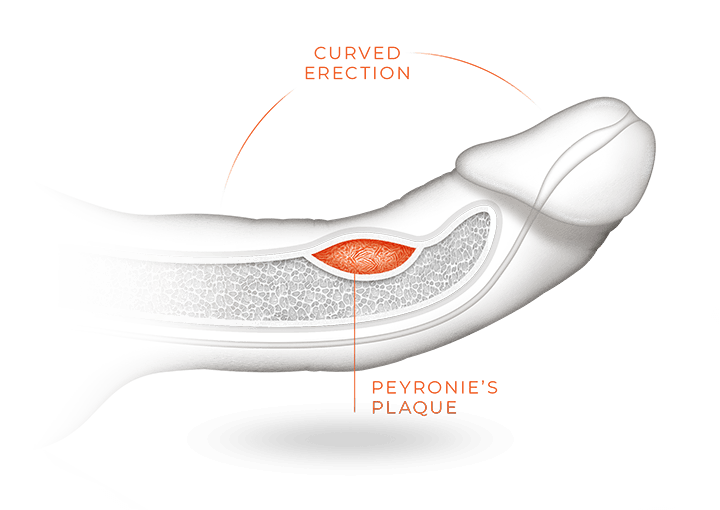Peyronies
How does erection occur?
The penis is composed of the urinary pathway, called the urethra, and two elastic sleeves, called the corpora cavernosa, which are the structures responsible for erection. With respect to urination, urine is made in the kidneys and transported through tubes to be stored in the urinary bladder, which holds urine until full and then empties to the outside through the urethra.
On either side of the urethra, there are the paired elastic sleeves, the corpora cavernosa, which are filled with blood vessels and are responsible for the process of erection. Erection develops when blood flows into these elastic sleeves and is trapped there to produce the increase in penile length and rigidity associated with erection.
What causes Peyronie’s disease? How does it affect the penis?
Peyronie’s disease develops when there is inflammation or scarring which develops in a portion of the elastic sleeve. The cause of this inflammation and scarring is unknown, but some suggest it may be due to microtrauma that can affect the erect penis. The portion of the elastic sleeve with inflammation or scarring does not stretch or expand completely.

Peyronie’s may present in a variety of ways.
- There may be pain or curvature of erection, which develops due to tethering in the area where the sleeve of the erectile structure loses its elasticity.
- A firm area or nodule can be felt, referred to as a Peyronie’s plaque.
- There may be incomplete filling which can cause the erect penis to have an “hourglass” or a “coke bottle” deformity, or a “divot” may be present due to incomplete filling.
- The erection may be soft beyond the involved area.
- Some men may have associated erectile dysfunction, meaning the erection is more difficult to get, the erection is less rigid, or they may get the erection but cannot maintain it.
How is Peyronie’s diagnosed?
The diagnosis of Peyronie’s disease is based on the above symptoms. As noted above, sometimes a plaque can be felt with physical exam. Occasionally, an ultrasound may be done to see if the plaque can be visualized. If a man has inability to get an erection, a testosterone level may be checked, but otherwise there are not any blood tests that are typically needed.
How is Peyronie’s treated?
The treatment of Peyronie’s disease is goal-oriented. Once again, it should be stated that it can be vexing to treat. Even though the condition was first described several hundred years ago, there are no easy treatment solutions. The natural history of Peyronie’s disease is variable. In a third of men it improves, in a third of men it stays the same, and in a third of men it progresses.
Medications
A variety of oral medications have been used to try to improve Peyronie’s. With the recognition that change in the elastic sleeve is caused by an inflammatory process, which in turn is triggered by chemical messages at the cellular level, different medications that can affect those cellular chemical response pathways have been used. Medications tried for Peyronie’s have included Vitamin E, Potaba (potassium aminobenzoate), and colchicine. Current studies suggest they may provide only limited benefit. Pentoxifylline (Trentral)may help in a subset of men.
The different pills available to help improve erection, Viagra, Cialis and Levitra, may work for some men. They can lead to a more rigid erection that is easier to get and maintain. However, with the increased blood flow, there may be more tethering of the area involved by the Peyronie’s disease which may cause more pain or curvature with erection.
Injections into the Peyronie’s plaque surgery
In addition to pills, other treatments have been developed that rely on direct injection of medication into the plaque itself. Different medications have been tied for direct penile injection, including Collagenase (Xiaflex), Verapamil, Nicardipine, and Interferon. Treatment schedules may require a dozen or more injections spread out at two- to three-week intervals. Investigational studies suggest there may be benefit for some patients.
Beyond drug therapy, other approaches have been explored to find improvement. Prior efforts have included the use of radiation therapy, and shockwave lithotripsy (a treatment also used for kidney stones), but they do not work. A penile traction device with weights (conceptually like the way traction is used to help with a bad back) may help some.
Surgery is used only as a last step. There is no substitute material to “patch” the elastic sleeve of the erectile body. Surgery is indicated when the degree of curvature is so severe that it is not possible to have intercourse. When surgery is carried out, the plaque is not excised. Rather, a “tuck” is made on the opposite side of the curve to make the penis straight.
Take Home Message
In summary, Peyronie’s disease is a common condition. For peace of mind, men can be reassured that the “knot” or hard area they feel is not a growth or cancer. Some measures are available that may provide some benefit, but identification of a reliable remedy remains a work in progress.
Additional Information
Contact us to request an appointment or ask a question. We're here for you.




